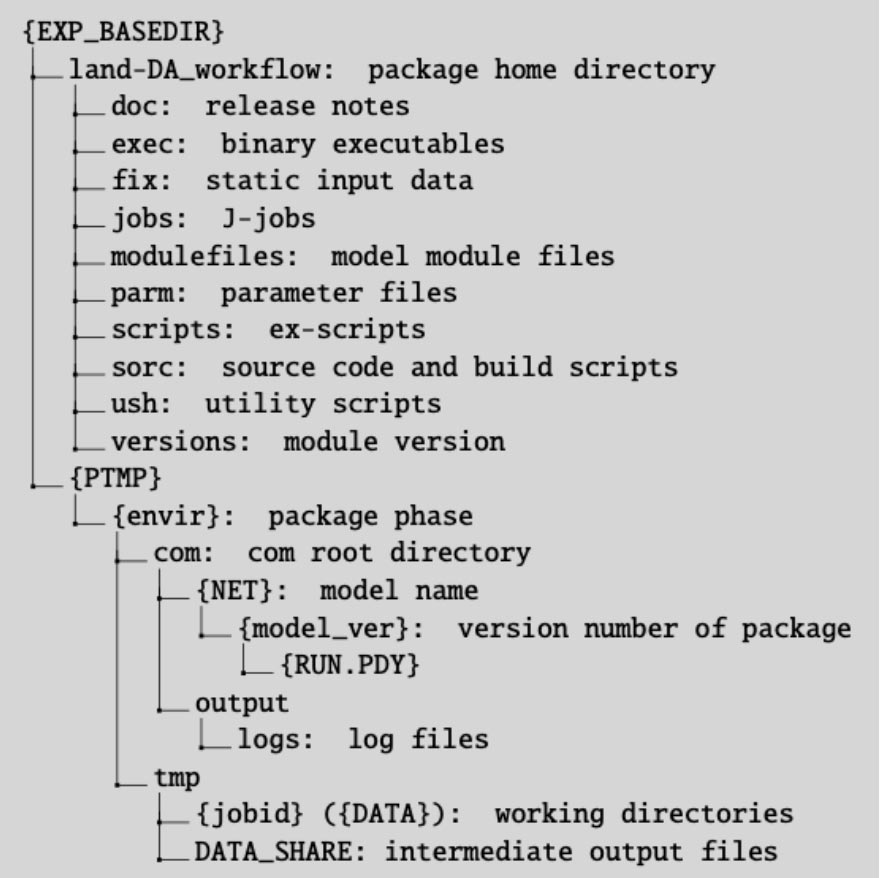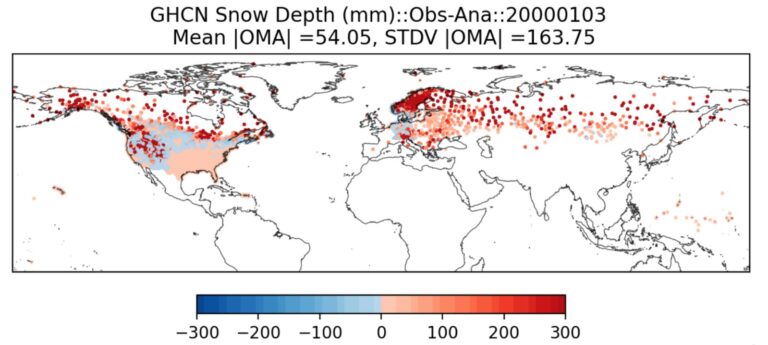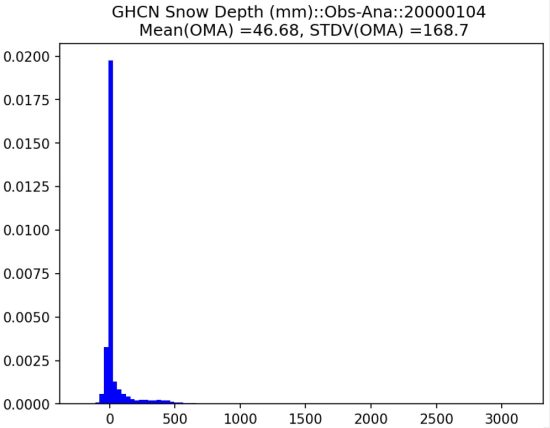Authors: Jong Kim, Chan-Hoo Jeon, Cory Martin, Zach Shrader, Gillian Petro
EPIC Teams: Code Management, and User Support
The Earth Prediction Innovation Center (EPIC) and the Unified Forecast System (UFS) community are proud to announce the public release of the Land Data Assimilation (DA) System v2.0.0. In the Land DA System, the Noah-MP land surface model (LSM) in the UFS Weather Model (WM) and the Joint Effort for Data assimilation Integration (JEDI) system are used to assimilate snow depth data via the Local Ensemble Transform Kalman Filter (LETKF) algorithm with pseudo-ensemble error covariance. This release is an update to the v1.2.0 release from December 2023 and reflects a number of changes currently available in the land-DA_workflow development branch. To improve the internal structure and maintainability of the Land DA workflow repository, EPIC developers have refactored the workflow to adhere more closely to the National Center for Environmental Prediction (NCEP) Central Operations (NCO) Implementation Standards. Additionally, developers have incorporated the Unified Workflow (UW) Tools open-source Python package to improve Rocoto workflow generation and automate common Land DA tasks needed for standard numerical weather prediction (NWP) systems.
The new release includes the following key feature updates:
- The Land DA System now uses a coupled configuration with the UFS Weather Model (WM) Noah-MP land component and the data atmosphere (DATM) component to run a sample case with GSWP3 atmospheric forcing data.
- A global C96 model resolution is provided for an analysis experiment time period of January 1-31, 2000.
- The stand-alone driver option to run the Noah-MP routines directly from the Common Community Physics Package (CCPP) has been removed.
- The workflow was refactored to use a standard set of environment variables, file naming conventions, and directory structures defined in the NCO Implementation Standards in order to generalize the DA workflow system and improve the troubleshooting process.
- A structured YAML-based Rocoto workflow management configuration approach was applied using uwtools to produce the Rocoto workflow XML file that manages a set of land DA cycling tasks, computational resources on a batch system, and computational job dependencies.
- Analysis outputs for the workflow end-to-end test can be validated with both the CTest framework and a baseline regression test that runs the Land DA workflow end-to-end. The post-processing task produces multiple plots, including histogram and scatter plots for the analysis task and restart plots for the forecast task.
The coupled Noah-MP/DATM Land DA configuration for the v2.0.0 release runs with atmospheric forcing files introduced through the Community Data Models for Earth Prediction Systems (CDEPS). Key state variables simulated by the UFS WM Noah-MP component model include soil moisture (both liquid and frozen), soil temperature, skin temperature, snow depth, snow water equivalent (SWE), snow density, canopy water content, and the energy flux and water flux terms of the surface energy balance and surface water balance. The UFS WM Noah-MP component can also be configured to run in two-way coupled mode with the active FV3 atmospheric model through the Community Mediator for Earth Prediction Systems (CMEPS). However, there is no analysis baseline test case for the coupled FV3/Noah-MP configuration at this time; efforts are underway to make such a case available.
The Land DA System uses spack-stack v1.6.0 as the prerequisite software stack and pairs it with JEDI software from the JCSDA Skylab v7.0 release. JEDI includes the Object-Oriented Prediction System (OOPS) for the data assimilation algorithm, the Interface for Observation Data Access (IODA) for observation formatting and processing, and the Unified Forward Operator (UFO) for comparing model forecasts and observations. It applies the JEDI LETKF algorithm with a pseudo-ensemble error covariance. Additionally, the Global Historical Climatology Network’s (GHCN’s) daily snow depth observation data have been processed with the JEDI IODA converter for the time period of January 1-31, 2000. The IODA-processed GHCN data is accessible in the Land DA data bucket.
The v2.0.0 User’s Guide has been updated to reflect these improvements to the Land DA System. Test cases with all associated data files are also available to the public in the Land DA data bucket. Interested users can get support by submitting a question through the GitHub Discussions Q & A page.
As detailed in the User’s Guide, the Land DA application is highly portable and runs on a wide variety of platforms, including NOAA Tier-1 Research and Development High-Performance Computing Systems (RDHPCS) Hera, Orion, and Hercules. Development code is tested nightly with a CTest pipeline integration run on these three platforms. Additionally, Singularity/Apptainer container images are available for download (ubuntu22.04-intel-landda-release-public-v2.0.0.img) and package the full software stack and pre-built Land DA System. The containers can be used to run through the full workflow on any high-performance computing system mentioned above as well as most other systems that use Intel compilers and MPI and a Slurm job scheduler. This broadens accessibility beyond those with access to NOAA RDHPCS.
The Land DA System v2.0.0 release is a collaboration between members from NOAA laboratories, centers, cooperative institutes, and community partners — notably the Earth Prediction Innovation Center (EPIC), the Environmental Modeling Center (EMC), the Physical Sciences Laboratory (PSL), the Joint Center for Satellite Data Assimilation (JCSDA), and the National Center for Atmospheric Research (NCAR) Climate & Global Dynamics (CGD) Laboratory. It uses the Joint Effort for Data Assimilation Integration (JEDI) framework developed by the JCSDA, the Earth System Modeling Framework (ESMF) developed by NCAR-CGD, and the CCPP software developed by the Developmental Testbed Center (DTC). Publicly available data is provided via an AWS S3 bucket established as part of the NOAA Open Data Dissemination (NODD) Program. Computing resources — Hera, Orion, and Hercules — used for preparation of this release were provided by NOAA High Performance Computing and Communications (HPCC) Program and NCAR Computational and Information System Laboratory (CISL).
Future work to expand the capabilities of the application will include continued enhancements to the R2O process and inclusion of additional analysis and model baselines. EPIC also has plans to continue expanding the observation database and the WE2E test framework to include additional analysis diagnostic options.
This release was funded by the NOAA Weather Program Office’s EPIC and the Joint Technology Transfer Initiative (JTTI) Programs, the National Weather Service (NWS) Office of Science and Technology Integration (OSTI) Modeling Programs, and the NOAA Disaster Supplemental Program. The Land Data Assimilation System page may be viewed in the EPIC Community Portal.













